 |
Fort Mississauga
Niagara-on-the-Lake, Ontario, Canada
|
|
 |
Constructed: 1814-1816
Used by: Great Britain, Canada
Conflict in which it participated:
War of 1812
|
Surrounded by a golf course, Fort Mississauga is a temporary field fortification turned permanent edifice on Lake Ontario. It is the only remaining star-shaped earthwork in Canada.*
The French had been trying to build fortifications at the mouth of the Niagara River since 1679, finding that a combination of absolutely awful weather and understandably uncooperative locals (Seneca Indians) made this a difficult spot in time and space to fortify.
|
 |
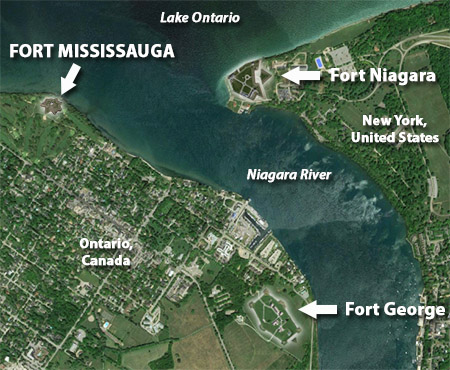 |
|
In the 1720's France began work on what would become Fort Niagara, which the British took from them in 1759, during the French and Indian War (1756-1763). Though after the American Revolutionary War (1775-1783) this fort was within the boundaries of the new United States, the British lingered in Fort Niagara until 1796, when the Jay Treaty finally made it COMPLETELY CLEAR THAT THEY WOULD BE LEAVING NOW THANK YOU VERY MUCH. All of this meant that Great Britain suddenly had no defenses at the extremely important mouth of the Niagara River. Great Britain immediately got to work on Fort George, just a smidge upriver (and on the opposite bank) from Fort Niagara. Fort George was completed in 1802. Plans had been afoot to build a 14-gun battery facing Fort Niagara at Mississauga Point in 1799, but once the impressive Fort George was completed, adding more guns to this mix seemed unnecessary. Instead, the first lighthouse on the Great Lakes was built at Mississauga Point in 1804. The name Mississauga refers to the Algonquin Mississauga Indians, who were present in the area when the French first arrived in the 17th century. The word means, "those at the great river mouth," which assumedly refers to the Niagara River where it meets Lake Ontario. |
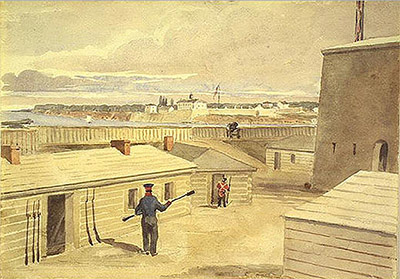 Fort Niagara, visible from (and within gun range of) Fort Mississauga during the War of 1812. Fort Niagara, visible from (and within gun range of) Fort Mississauga during the War of 1812. |
 |
On June 18, 1812, US President James Madison (1751-1836) declared war on Great Britain. While much of the War of 1812 (1812-1815) did not go particularly well for the declaring party, one thing the United States did accomplish with style and verve was the capture of Fort George, on May 27, 1813.
The Americans believed that the lighthouse at Mississauga Point was packed full of gunpowder, so gave it a wide berth when choosing landing spots for their Canadian invasion. The Canadian Militia had mounted some guns at Mississauga Point, which in preparation for the American assault were blasted by the USS Julia, a schooner with two guns, and USS Growler, a sloop with 11 guns, of the US Navy. |
|
|
The British troops that had been ejected from Fort George thanks to the excellent planning and leadership of Colonel Winfield Scott (1786-1866) scampered to Burlington Heights, a fortified position at the far western tip of Lake Ontario. While the Americans had been great at capturing Fort George, they proved less great at further endeavors inland, perhaps in part due to the fact that Winfield Scott had been wounded at the battle of Fort George, removing him from the field until later in the war. Britain was victorious at both the Battle of Stoney Creek (June 6, 1813) and the Battle of Beaver Dams (June 24, 1813), and the demoralized Americans would abandon Fort George on December 10, 1813.
|
The American commander at Fort George, Brigadier General John Parker Boyd, was under orders to burn the nearby town of Newark if his position was threatened. Newark had, for a time, been the capital of Upper Canada, until its close proximity to a belligerent United States inspired the Canadians to move their capital north to the city of York, which would later be renamed Toronto.
If Boyd were to find it necessary to torch Newark, his orders stated, he would do so in the most polite manner possible, first warning the townspeople of his intention and giving them ample time to vacate. Oddly, it didn't work out that way.
|
 |
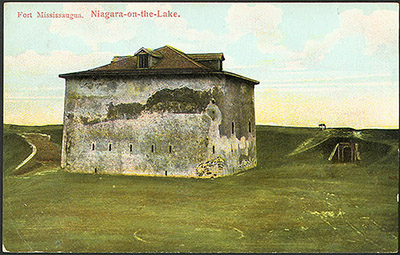 The tower of Fort Mississauga, 1910 The tower of Fort Mississauga, 1910 |
|
It seems that Boyd's characteristic role in most tense situations was to lose control over them. True to form, just before abandoning Fort George, things got out of hand and American troops put Newark to the torch without warning anyone, dumping the town's dazed populace into the snow. This needless destruction enraged the British, who would burn several American towns in retribution when it shortly became their turn to invade their enemy's land and capture their starforts.
|
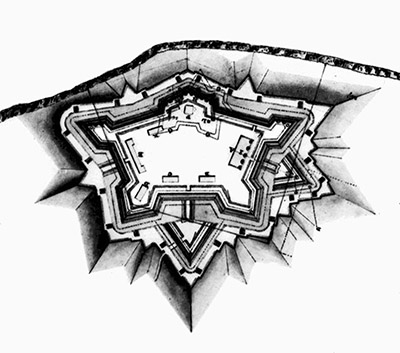
The Fort Mississauga that never was. From an optimistic British plan of 1816: Had this version of Fort Mississauga been constructed, it would have been the largest fort in Canada. Click here to see the whole map, which also features a fancified Fort George, and a Fort Niagara that actually looks like Fort Niagara! |
 |
Meanwhile, the British again needed a fort at the mouth of the Niagara River. The Americans had pretty effectively destroyed Fort George in addition to the town of Newark, so work began on a new, better-sited fortification: Fort Mississauga.
Work began in the Spring of 1814, with the rubble of Newark (and stone from the dismantled lighthouse) being utilized as a handy building material for the foundation of Fort Mississauga's most arresting feature, its tower. Which is really a blockhouse, but we're calling it a tower anyway.
That tower was only two feet high when the Americans came to visit in July of 1814, in the form of a force led by General Jacob Brown (1775-1828). History apparently did not record Brown's findings, so I would like to assume that he and his men saw a two-foot-tall tower surrounded by muddy earthworks, jeered, and left. |
|
|
Another possibility seems to be that an American brigade of 3000 men under Colonel Moses Porter (1755-1822) advanced on what must have been a diminutive Fort Mississauga in July of 1814, only to be chased away by long-range cannon fire from the fort. These two events may or may not have happened, as they are briefly described in the signage at the fort, but I cannot find mention of them elsewhere. Both Brown and Porter fought heroically at the Siege of Fort Erie in August of 1814, and these actions may have been misattributed to Fort Mississauga. The starfort of our current interest did have impressive, 20-foot thick, star-shaped earthworks by the end of 1814, along with a series of log buildings within those walls, in which the garrison spent its lonely days. Perhaps fortunately for Fort Mississauga, it was left alone for the remainder of the war. The tower was only nine feet high in 1816, but was finally completed in 1823. In 1837 and 1838, a series of rebellions broke out in Canada, led by Canadians yearning for "responsible government." While a government reeking of responsibility was indeed created not long after these rebellions, these events nonetheless freaked Great Britain out, and Fort Mississauga's defenses were bolstered as a result.
|
In 1838, a reinforced platform was added on the fort's upper level, upon which a single cannon was mounted. The fort's earthen walls were increased to a 40-foot thickness, and were twelve feet high. A double row of sharpened logs jutted menacingly from the outer walls, and an earthwork ravelin was added to protect the main gate.
The inside of the tower consists of two casemated rooms, which would have served as a barracks and living space during a bombardment. A storehouse and powder magazine occupied two basement rooms. The walls of the tower are eight feet thick at the base, tapering to a seven-foot thickness at the top. The tower is 25 feet high.
By 1852 Fort Mississauga was at its peak of pointy, sharpened pugnaciousness. Over a dozen cannons were somehow crammed into the little fort. Despite its impressive spininess, Great Britain abandoned the fort in 1855.
|
 |
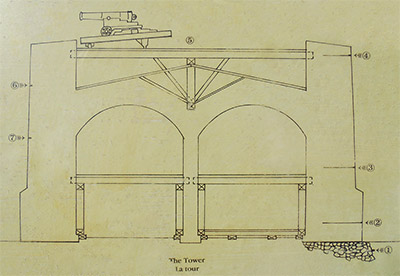 A cross-section of Fort Mississauga's tower, from signage at the fort:
(1) Rubble from the 1792 town of Newark placed in 1814
(2) July 1814-Americans attack the tower which is only two feet high
(3) April 1816-The tower is only nine feet high
(4) 1823-The tower is substantially complete
(5) 1838-Upper battery for artillery is installed
(6)1840's-Stucco parging is applied to the tower to protect brickwork
(7) WWI-Soldiers put concrete parging on the tower's exterior |
|
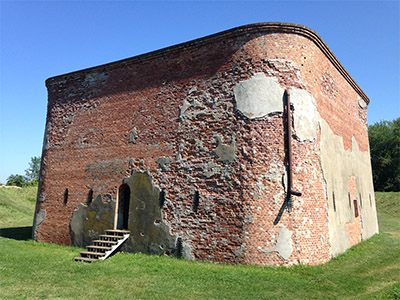 Fort Mississauga's distinctive tower in 2015. Much of the First World War-era concrete parging remains! |
 |
Canada became a (semi-) independent nation in 1867. Two important things happened to Fort Mississauga in the 1870's: Canadian troops began using it for training, and a 9-hole golf course was constructed around it.
Through both World Wars and the Korean Conflict (1950-1953), Canada trained troops at Fort Mississauga: I'm sure familiarization with a blockhouse built in the early 19th century prepared them well for modern combat!
Today, Fort Mississauga is a National Historic Site of Canada, and is surrounded by the course of the Niagara-on-the-Lake Golf Club. |
|
|
I visited Fort Mississauga in August of 2015! If you're interested in seeing more of how the fort looks today, perhaps you'll visit the Fort Mississauga page in the Starforts I've Visited section. *The claim that Fort Mississauga is the only remaining star-shaped earthwork in Canada is made in the signing at the fort. Claims such as "biggest," "oldest," and "last remaining" seem to often be made locally at starforts without much in the way of research, or with a whole lot of qualifications affixed thereto. Fort Mississauga may be the only star-shaped earthwork remaining in Canada, but...Canada is a big place. Be careful with those heroic superlatives, starforts!
|
|
|
|
|
|
 |




